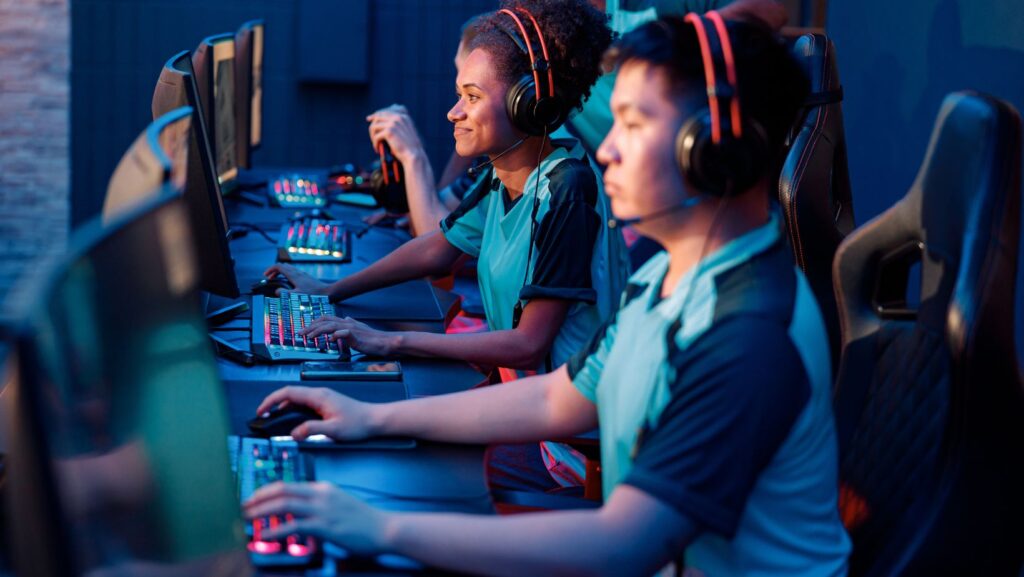Professional gaming events aim to be at the cutting edge of technology, and integrating the right multiviewer technology is just one way they can accomplish this. In this post, we’ll highlight how these tools can make a massive difference in esports.
Monitoring Multiple Feeds
The main purpose of a multiviewer is to put several feeds on a single screen, lowering the effort of switching between them. In esports tournaments and events, this goes from a convenience to an absolute necessity.
Tournament attendees won’t always want to choose one player to follow. They might want to, for example, see a whole team’s performance at once, or watch both perspectives on a 1v1 match.
In these situations, a multiviewer heightens the tension of a viewing experience. Viewers know if the player they’re following has an opponent just around the corner, or if they’re about to fall into an enemy trap.
While multiviewers are great for regular attendees, they’re arguably more critical for the event’s staff. Here’s how behind-the-scenes crews (including referees and commentators) use them:
- To check if anyone is cheating or otherwise exploiting a game’s bugs
- To verify any crashes/performance issues players claim to have had
- To give accurate and balanced commentary on all sides of a match
- To inform production teams which graphics or text to show on-screen
Ensuring Smooth Live Broadcasts
Multiviewers are particularly popular in broadcasting, making them perfect for esports events, as these are frequently streamed on platforms such as YouTube and Twitch. The venue might even have a Jumbotron that shows the “official” livestream.
A gaming event’s technical director (and their team) needs to see everything at once, including:
- Each player’s point of view
- Observer feeds
- Stage cameras
- Audience cameras
- Analyst desk cameras
They also need to be able to insert sponsorship messages, replays, and any extra graphics and necessary text. For example, they can show a live scoreboard or, if the match is timed, they can display a more prominent countdown than the game.
A multiviewer lets stream teams ensure that one shot flows seamlessly into the next. Esports is incredibly fast-paced, so a sudden slowdown as technicians scramble to switch live feeds could make people’s attention spans wander, instantly killing the flow.
Creating Custom Feeds
Referees, producers, and viewers all need different views of the action. This is because they all have their own “priorities” while watching. Here’s how multiviewers can help everyone here:
Viewers
Attendees and stream viewers are mainly concerned about the action itself, meaning they might not see a multiviewer at all. The behind-the-scenes teams will instead curate a single screen for them. If they do watch on a multiviewer, this will only show multiple players’ perspectives.
Referees
Referees, meanwhile, need more information about the games so they can stay on the hunt for cheaters; this means they’ll likely see the player cameras too. A multiviewer is critical here and can act as a VAR, replaying recent moments to help referees with decisions.
Producers
Producers need more of a technical view. They’ll see virtually everything, including the stage view and all outgoing feeds. A multiviewer allows them to decide exactly what they should cut to next — and when.
Staying Ahead of Latency
No esports event can go ahead if lag’s a concern. At a minimum, players might constantly claim their defeats were due to a poor connection. This is also important for the production team; they need a truly live view of everything.

Here’s why a multiviewer needs low latency to do its job at an esports event:
- A video filled with lag could stop viewers from seeing a clutch play
- Only a real-time feed can accurately spot cheating or rule violations
- Producers must be able to cut to a replay without missing anything
- Commentators could otherwise fall behind what everyone else sees
- Viewers shouldn’t hear the audience cheering before a big moment
Final Thoughts
Multiviewers keep gaming and esports events fair, fun, and frenetic, but only if everyone has the correct display (with minimal lag). If you’re setting up a tournament, consider using multiviewers to deliver a truly dynamic experience.



